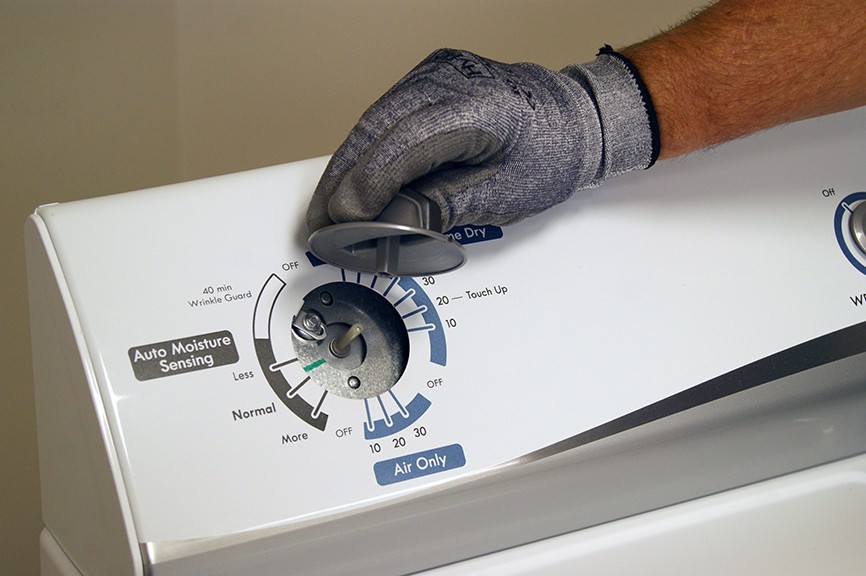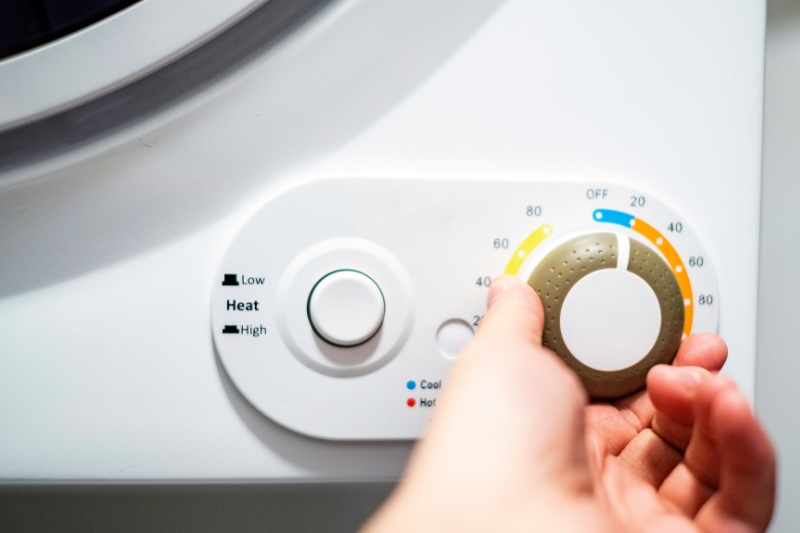Is your dryer timer not working? When it comes to doing laundry, a dryer is an essential appliance that saves you time and effort. The timer is a crucial component of the dryer that controls the drying time and cycle.
If it's not functioning correctly, your clothes may come out damp or over-dried, and the drying process may take longer than usual. Don't panic, though; there are several reasons why your dryer timer might not be working. We will discuss these reasons and provide you with the necessary steps to troubleshoot the problem and get your dryer back to its optimal functioning state.
Dryer Timer Not Working - What's The Reason?
The dryer timer is an essential component of your dryer that controls the drying time and cycle. If your dryer timer is not working properly, there could be several reasons why, including:
- Faulty Timer Motor- The timer motor is responsible for advancing the timer through each cycle. If the motor is faulty, the timer will not work correctly.
- Broken Timer Knob- The timer knob is connected to the timer shaft and allows you to select the drying time and cycle. If the knob is broken, the timer may not function properly.
- Loose or Damaged Wiring - Loose or damaged wiring connections can cause the timer to malfunction. It's important to check the wiring connections to ensure they are secure and free from damage.
- Dirty Contacts- Dirt and debris can accumulate on the timer contacts and prevent them from functioning correctly. Cleaning the contacts may solve the problem.
- Defective Timer Control Board - The timer control board is responsible for controlling the functions of the timer. If the board is defective, the timer may not work correctly.
If you are experiencing issues with your dryer timer, it's essential to troubleshoot the problem to determine the cause and resolve it promptly.
How To Tell If A Dryer Timer Is Bad
If you suspect that your dryer timer is not functioning properly, there are a few signs to look out for:
- Dryer not starting or not shutting off after the set cycle time has elapsed
- Dryer not advancing through the different cycles or getting stuck in one cycle
To determine if the timer is indeed the issue, you can:
- Visually inspect the timer for any signs of damage or wear and tear
- Use a multimeter to test the continuity of the timer contacts
How To Reset A Dryer Timer
Resetting a dryer timer is a fairly simple process. Here are the steps to follow:
- Unplug the dryer from the power source to ensure your safety.
- Locate the timer knob and turn it to the "off" position.
- Wait for a few minutes before turning the knob back to the desired cycle.
- Finally, plug the dryer back in and test to see if the timer has been successfully reset.
If the timer still does not work, it may be necessary to replace the timer altogether.
How To Test The Dryer Timer
Testing a dryer timer requires the use of a multimeter to check the continuity of the timer contacts. Here's how todo it:
- Unplug the dryer and remove the back panel to access the timer.
- Set the multimeter to the ohms setting and touch the probes to the timer contacts.
- If there is no continuity, the timer is faulty and needs to be replaced.
- If continuity is present, you should check other parts of the dryer, such as the thermal fuse or thermostat, to determine the root cause of the issue.
How To Test Your Dryer's Cycling Thermostat With A Multimeter
To test your dryer's cycling thermostat, you will need a multimeter set to the ohms setting. Here's how to do it:
- Unplug the dryer and remove the back panel to access the thermostat.
- Disconnect the thermostat's wires and place the multimeter probes on the thermostat terminals.
- If the thermostat is functioning properly, the multimeter should display a reading of zero ohms.
- If the reading is higher than zero, the thermostat is faulty and needs to be replaced.
It's important to note that cycling thermostats are designed to cycle on and off to regulate the temperature in the dryer, so if the dryer is overheating or not heating at all, the cycling thermostat may be the culprit.

Dryer Not Drying? Cycling Thermostat Testing, Troubleshooting
How To Calibrate A Dryer Timer
If your dryer timer is not keeping accurate time or the cycle is ending too soon or too late, it may need to be calibrated. Here are the steps to calibrate the timer:
- Unplug the dryer from the power source to ensure your safety.
- Remove the back panel of the dryer to access the timer.
- Locate the calibration dial on the timer and use a screwdriver to adjust it.
- Turn the dial clockwise to increase the time and counterclockwise to decrease the time.
- Test the dryer to ensure that the timer is now keeping accurate time and that the cycle is ending at the desired time.
- If the timer is still not functioning properly, it may need to be replaced.
How To Replace A Dryer Timer
If you have determined that the dryer timer is the issue and needs to be replaced, here are the steps to follow:
- Unplug the dryer from the power source to ensure your safety.
- Remove the back panel of the dryer to access the timer.
- Take a picture of the existing timer connections or make a note of the wire colors and their corresponding terminals to ensure proper reinstallation.
- Disconnect the wires from the timer and remove it from the dryer.
- Install the new timer in the same location and connect the wires in the correct order.
- Reattach the back panel of the dryer and plug it back in.
- Test the dryer to ensure that the new timer is functioning properly.
How To Clean A Dryer Timer
If your dryer timer is not functioning properly, it may be due to dirt or debris build-up. Here are the steps to clean the timer:
- Unplug the dryer from the power source to ensure your safety.
- Remove the back panel of the dryer to access the timer.
- Use a soft-bristled brush to gently clean the timer contacts and surrounding areas.
- If there is a significant amount of dirt or debris, you may want to use a small amount of rubbing alcohol and a cotton swab to clean the contacts.
- Once the timer is clean, reattach the back panel of the dryer and plug it back in.
- Test the dryer to ensure that the timer is now functioning properly.
People Also Ask
How Can I Tell If My Dryer Timer Is The Problem Or If It's Another Component Of My Dryer Causing The Issue?
If your dryer is not working correctly, it can be challenging to determine the root cause of the problem. However, if your dryer is not advancing through the cycles, or if the drying time is too long or too short, it's likely that the timer is the culprit. You can test the timer with a multimeter or perform a visual inspection to see if there are any signs of damage or wear.
How Often Should I Clean Or Calibrate My Dryer Timer To Ensure It Is Functioning Properly?
It's recommended to clean your dryer timer at least once a year to prevent dirt and debris buildup, which can cause the contacts to malfunction. As for calibration, it's generally only necessary if you notice that the timer is not keeping accurate time or the cycle is ending too soon or too late.
Can I Replace A Dryer Timer On My Own, Or Do I Need To Hire A Professional To Do It?
Replacing a dryer timer is a relatively simple task that you can do on your own. However, it's important to ensure that you have the correct replacement part for your dryer model and that you follow the manufacturer's instructions carefully to avoid damaging other components.
What Are Some Signs That Indicate My Dryer Timer Needs To Be Replaced?
Some signs that your dryer timer needs to be replaced include the timer not advancing, the cycle not ending at the desired time, or the dryer not starting at all. You may also notice that the timer knob is loose or that the timer is making a ticking or buzzing sound.
How Can I Prevent My Dryer Timer From Malfunctioning In The Future?
To prevent your dryer timer from malfunctioning in the future, it's important to clean it regularly, avoid overloading your dryer, and use the correct settings for each load. Additionally, you can protect your dryer timer from power surges by using a surge protector and avoiding sudden power outages.
Conclusion
In conclusion, a malfunctioning dryer timer can be a frustrating and inconvenient problem. However, by understanding the common causes of a dryer timer not working and following the troubleshooting steps outlined in this article, you can get your dryer up and running in no time.
Remember to always prioritize your safety and unplug the dryer before attempting any repairs or cleaning. Whether you need to replace the timer, clean it, or calibrate it, these steps will help you get the job done efficiently and effectively.
Don't let a faulty dryer timer disrupt your laundry routine any longer; take action today to ensure your dryer is functioning at its best.

